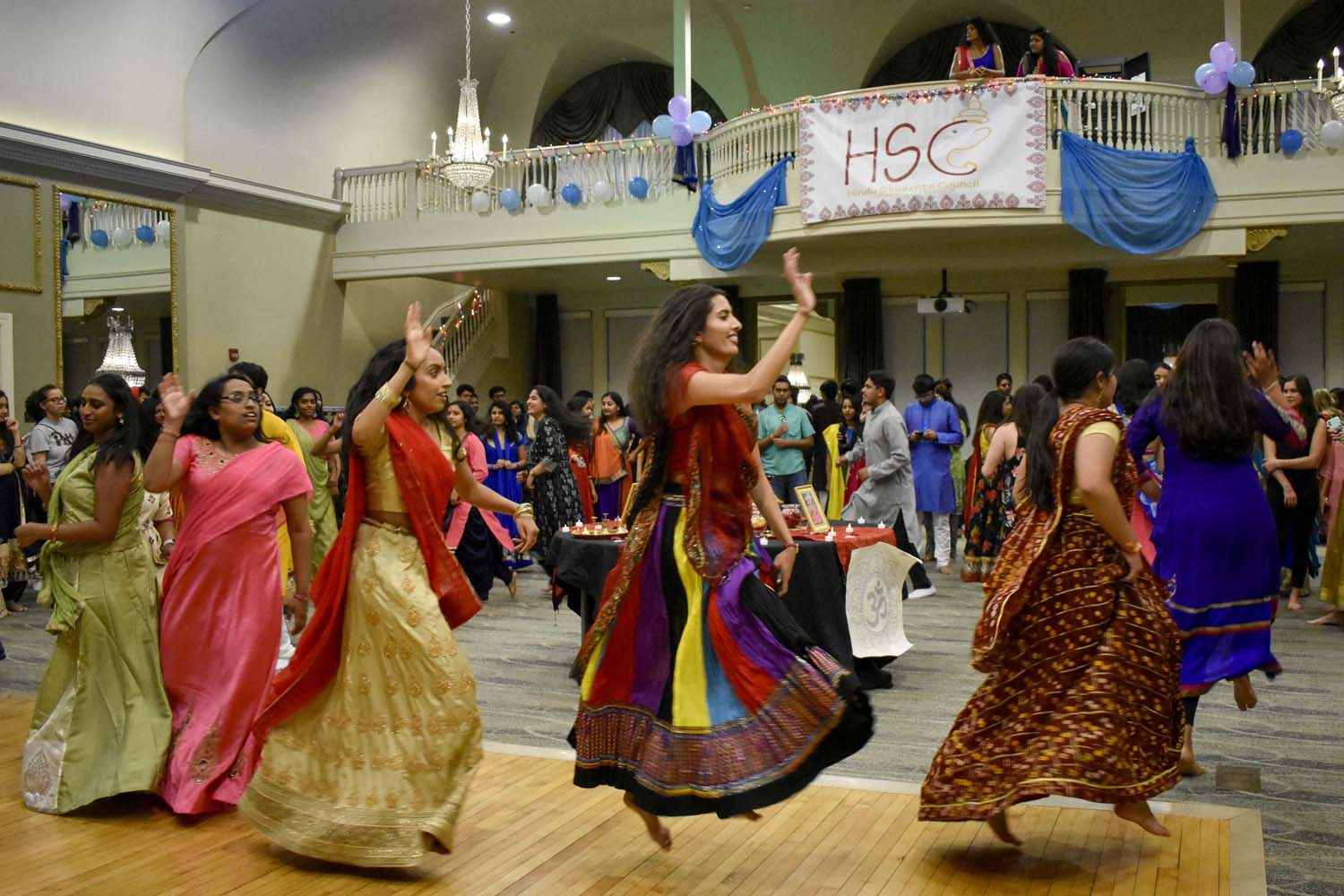Hindu Students Council celebrates Navaratri with garba bash


Participants dance in circles in the O’Hara Student Center ballroom during the Hindu Students Council’s Navaratri celebration.
Students dressed in brightly colored dresses and tunics danced in circles around a decorated table in the center of the dance floor in the ballroom of the O’Hara Student Center, where a framed picture of a Hindu goddess sat surrounded by candles. Downstairs, partygoers were welcomed by the thumping of hundreds of dancing feet.
Three hundred Pitt and CMU students alike prayed, danced and ate at a celebration hosted by the Pitt Hindu Students Council on Saturday night from 6 p.m. to 10 p.m. to honor Navaratri, an Indian festival which takes place for nine days every autumn.
With religious ties to Hinduism and other religions native to India, Navaratri is celebrated differently across the subcontinent. In the northern and western states of India, Navaratri celebrates the Hindu god Rama’s victory over the demon king Ravana, but in the southern states, it is more of a celebration of the divinity of several goddesses.
The festival traditionally consists of prayer, dancing and multiple feasts. The Hindu Students Council provided small-scale versions of each — a prayer before the dance and food provided about halfway through the night from the India on Wheels food truck.
Though the festival has religious origins, it’s not unusual for people of all religions to come together during Navaratri to celebrate life. Kashish Mehendiratta, Dharma chair of the Hindu Students Council, said Navaratri provides happiness to all involved by creating a sort of cleansing of the soul.
“Navaratri is basically a festival where we worship a goddess, the goddess of divine. It represents the reign of good over evil. Navaratri goes on for nine days and on the 10th day it ends because Rama killed the king, which is why we celebrate. It’s about the happiness of the mind, soul and body,” she said.
The dancing — an Indian style called garba — never stopped, with few breaks in between numbers. A new dancing circle started every time the previous one ended. Originating from the western Indian state of Gujarat, garba consists of dance movements in circles. Rings of dancers formed around the framed centerpiece of the goddess Durga.
There were different variants of garba for each new song, each with their own kind of steps and hand movements. Some of the attendees seemed hesitant to join in the beginning and lingered in small groups closer to the walls of the ballroom. Though initially reminiscent of a middle school dance, with so many people clinging to the circle’s edge looking on with apprehension, the awkwardness didn’t linger for long. As more students flowed in, the floor became flooded with experts and newbies alike.
Uma Gosai, a sophomore biology major, said that even though the dances may be difficult to some with all their intricacies, everyone was welcome at the event to enjoy themselves.
“The appeal of it is really you just get to dance with your friends. It’s a good get-together type of thing,” she said. “The dances are easy, well easier at least than some others. It’s not for everyone but they’re fun to do once you get into them.”
Navaratri is such an important event in India that, despite the differences between the gods and goddesses celebrated in each region, most kids get the full nine days off from school. Pooja Tallapaneni, an undecided first-year, said back at her home in California, garba is just as big for her as it is in India, and that the holiday serves as a connective event for the community.
“We do it big in California, anywhere where there’s a decent amount of Indian people this will happen in November or October,” she said. “It’s like a huge community thing.”
Students of all cultural and ethnic backgrounds attended the event, not just those of Indian descent. Many of them joined in on the dancing, some even in full garba dress — vibrant embroidered tunics and skirts decorated with beads and other adornments.
Halfway through the event it was time for dinner. Half of the now-full ballroom shuffled downstairs to the dining room to enjoy naan, rice and curry. The dining room was just as lively as the ballroom above. Over the sound of dinnertime chatter, one could make out the patter of feet from above because at Navaratri, no one ever stops dancing.
Mehendiratta said that she hadn’t known about garba prior to attending Pitt and was amazed to find that, when Navaratri came around, Indian students were eager to bring their friends along and introduce them to this part of their culture.
“I did not know about this dance form, I never did it,” she said. “And when I came here and saw so many people who were doing it, it was amazing.”
Recent Posts
SGB introduces new governing code bill and addresses rumors of ICE on campus
At its weekly meeting at Nordy’s Place on Tuesday, Student Government Board introduced an omnibus…
Opinion | School should be in the summer
Although this may be controversial, I believe that from this data, it is evident that…
Weathering the storm: Pittsburgh teams have tackled some of the toughest environments
The end of the year in western Pennsylvania is always marked by two things —…
Notes From an Average Girl // Notes on Book Banning
In this edition of Notes From an Average Girl, senior staff writer Madeline Milchman writes…
To Be Honest // Yup, it is that damn phone
In this edition of To Be Honest, staff writer Evin Verbrugge writes about her phone…
Meaning at the Movies | Portraying Toxic ‘Adolescence’
In this edition of Meaning at the Movies, staff writer Lauren Deaton explores the mini-series…

